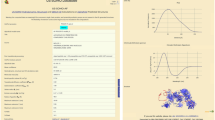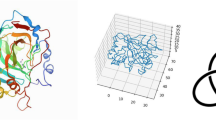Abstract
THE number of all possible conformations of a polypeptide chain is too large to be sampled exhaustively. Nevertheless, protein sequences do fold into unique native states in seconds (the Levinthal paradox). To determine how the Levinthal paradox is resolved, we use a lattice Monte Carlo model in which the global minimum (native state) is known. The necessary and sufficient condition for folding in this model is that the native state be a pronounced global minimum on the potential surface. This guarantees thermodynamic stability of the native state at a temperature where the chain does not get trapped in local minima. Folding starts by a rapid collapse from a random-coil state to a random semi-compact globule. It then proceeds by a slow, rate-determining search through the semi-compact states to find a transition state from which the chain folds rapidly to the native state. The elements of the folding mechanism that lead to the resolution of the Levinthal paradox are the reduced number of conformations that need to be searched in the semi-compact globule (˜1010 versus ˜1016 for the random coil) and the existence of many (˜103) transition states. The results have evolutionary implications and suggest principles for the folding of real proteins.
This is a preview of subscription content, access via your institution
Access options
Subscribe to this journal
Receive 51 print issues and online access
$199.00 per year
only $3.90 per issue
Buy this article
- Purchase on Springer Link
- Instant access to full article PDF
Prices may be subject to local taxes which are calculated during checkout
Similar content being viewed by others
References
Creighton, T. E. (ed.) Protein Folding (Freeman, New York, 1992).
Levinthal, C. in Mossbauer Spectroscopy in Biological Systems (eds Debrunner, P., Tsibris, J. C. M. & Münck, E.) 22–24 (Univ. Illinois Press, Urbana, 1969).
Shakhnovich, E., Farztdinov, G., Gutin, A. M. & Karplus, M. Phys. Rev. Lett. 67, 1665–1668 (1991).
Šali, A., Shakhnovich, E. I. & Karplus, M. J. molec. Biol. 235, 1614–1636 (1994).
Harding, M., Williams, D. & Woolfson, D. Biochemistry 30, 3120–3128 (1991).
Wetlaufer, D. B. Proc. natn. Acad. Sci. U.S.A. 70, 697–701 (1973).
Kim, P. & Baldwin, R. A. Rev. Biochem. 59, 631–660 (1990).
Gõ, N. & Abe, H. Biopolymers 20, 1013–1031 (1981).
Honeycutt, J. D. & Thirumalai, D. Biopolymers 32, 695–709 (1992).
Bryngelson, J. D. & Wolynes, P. G. J. phys. Chem. 93, 6902–6915 (1989).
Shakhnovich, E. I. & Gutin, A. M. Biophys. Chem. 34, 187–199 (1989).
Dill, K. A. Biochemistry 24, 1501–1509 (1985).
Dilorio, E. E. et al. Proc. natn. Acad. Sci. U.S.A. 90, 2025–2029 (1993).
Stetter, K. O. in Frontiers of Life (eds Trân Thanh Vân, J. K., Mounolou, J. C., Schnieder, J. & McKay, C.) 195–212 (Editions Frontières, Gif-sur-Yvette, France, 1992).
Gõ, N. & Abe, H. Adv. Biophys. 18, 149–164 (1984).
Bryngelson, J. D. & Wolynes, P. G. Proc. natn. Acad. Sci. U.S.A. 84, 7524–7528 (1987).
Karplus, M. & Weaver, D. L. Nature 260, 404–406 (1976).
Taketomi, H. & Gõ, N. Int. J. Peptide Prot. Res. 7, 445–449 (1975).
Miyazawa, S. & Jernigan, R. L. Macromolecules 18, 534–552 (1985).
Metropolis, N., Rosenbluth, A. W., Rosenbluth, M. N., Teller, A. H. & Teller, E. J. chem. Phys. 21, 1098–1092 (1953).
Sykes, M. F. J. chem. Phys. 39, 410–412 (1963).
Loncharich, R. J. & Brooks, B. R. J. molec. Biol. 215, 439–455 (1990).
Author information
Authors and Affiliations
Rights and permissions
About this article
Cite this article
S˘ali, A., Shakhnovich, E. & Karplus, M. How does a protein fold?. Nature 369, 248–251 (1994). https://doi.org/10.1038/369248a0
Received:
Accepted:
Issue Date:
DOI: https://doi.org/10.1038/369248a0
This article is cited by
-
Protein folding rate evolution upon mutations
Biophysical Reviews (2023)
-
Processing binding data using an open-source workflow
Journal of Cheminformatics (2021)
-
Escape dynamics of active particles in multistable potentials
Nature Communications (2021)
-
Sampling of the conformational landscape of small proteins with Monte Carlo methods
Scientific Reports (2020)
-
Proteomimetics as protein-inspired scaffolds with defined tertiary folding patterns
Nature Chemistry (2020)
Comments
By submitting a comment you agree to abide by our Terms and Community Guidelines. If you find something abusive or that does not comply with our terms or guidelines please flag it as inappropriate.



